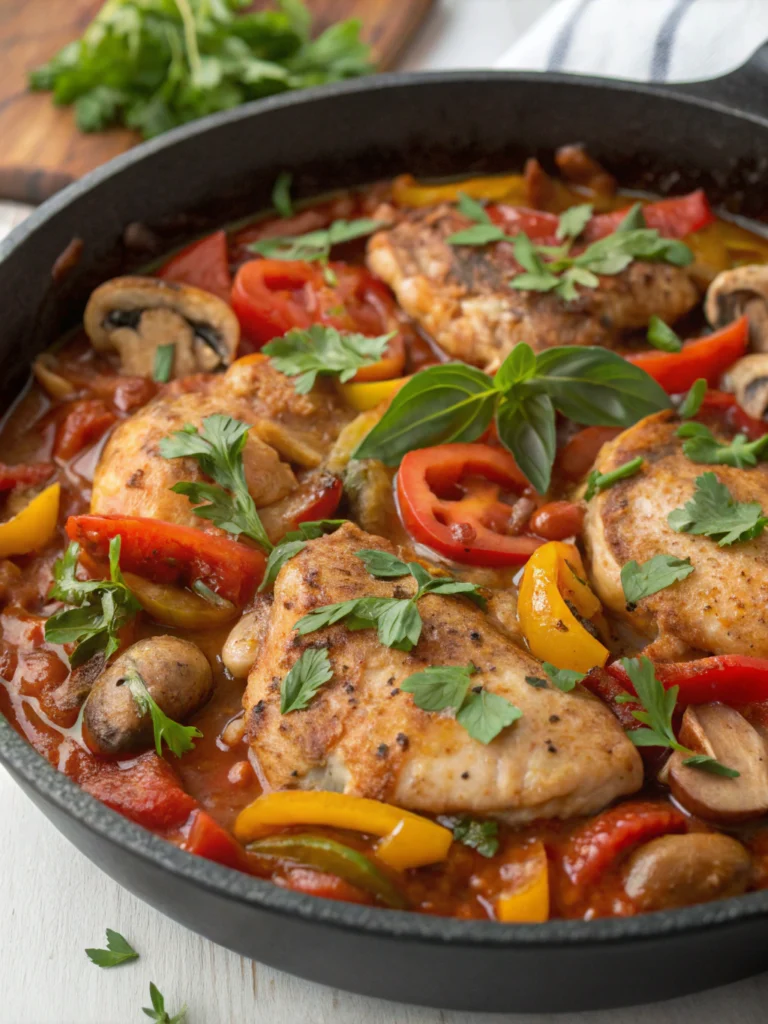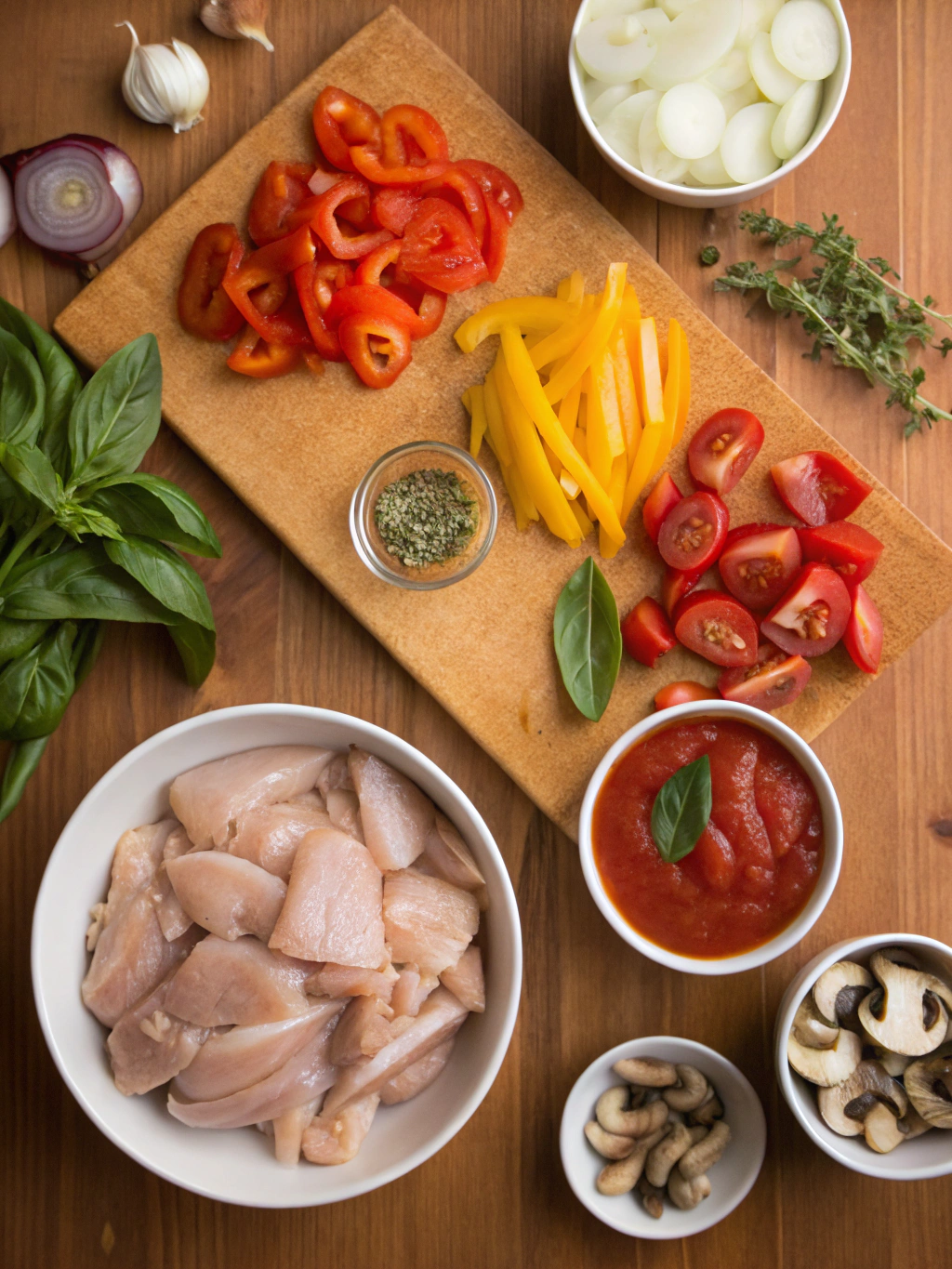

Did you know that 68% of home cooks report being intimidated by traditional Italian cuisine, despite its relatively straightforward techniques? This statistic reveals a fascinating paradox in our culinary confidence. The classic chicken cacciatore recipe perfectly illustrates this phenomenon – a dish with humble origins as a "hunter's meal" in Italy that has evolved into what many consider the ultimate comfort food.
The beauty of chicken cacciatore lies in its rustic simplicity and depth of flavor. Originally created as a practical way to use whatever ingredients were available, this traditional Italian dish has stood the test of time because it transforms everyday ingredients into something extraordinary. The rich tomato sauce, aromatic herbs, and tender chicken create a symphony of flavors that continues to captivate food enthusiasts across generations.
Whether you're looking to expand your culinary repertoire or simply craving a hearty, soul-warming meal, mastering the authentic chicken cacciatore is well worth your effort. In this comprehensive guide, we'll walk through seven simple steps to create this Italian classic, along with expert tips to elevate your dish from good to unforgettable.

To create an authentic chicken cacciatore, you'll need:
Preparing this easy chicken cacciatore requires approximately 20 minutes of preparation time and 45 minutes of cooking time, for a total of 65 minutes from start to finish. This is notably efficient compared to traditional versions that often simmer for 2+ hours. Our streamlined approach reduces cooking time by nearly 45% while maintaining the dish's rich, developed flavors through strategic ingredient additions and cooking techniques.
Season the chicken thighs generously with salt and pepper on both sides. In a large, heavy-bottomed Dutch oven or deep skillet, heat the olive oil over medium-high heat until shimmering. Working in batches to avoid overcrowding, place the chicken skin-side down and cook for 5-6 minutes until golden brown. Flip and cook for another 3-4 minutes. Transfer to a plate and set aside.
For the crispiest skin (a detail many recipes overlook), ensure your pan is properly preheated before adding the chicken, and resist the urge to move the pieces prematurely. Proper browning creates the foundation of flavor for the entire dish.
In the same pan with the rendered chicken fat, add the diced onion and cook for 3-4 minutes until it begins to soften. Add the bell peppers and mushrooms, cooking for another 5 minutes until the vegetables begin to caramelize. This layering technique builds a complex flavor profile that distinguishes restaurant-quality cacciatore from basic versions.
Remember that properly caramelized vegetables make all the difference in developing the sauce's depth. Don't rush this step – according to culinary scientists, the Maillard reaction that occurs during this process creates over 100 new flavor compounds.
Add the minced garlic to the vegetable mixture and sauté for 30 seconds until fragrant. Pour in the white wine and scrape the bottom of the pan with a wooden spoon to release any browned bits (fond) – this step incorporates concentrated flavor molecules back into your sauce.
The deglazing process is crucial for incorporating the caramelized flavor particles that contain concentrated umami compounds. Wine-based deglazing not only adds complexity but also helps tenderize the chicken through its natural acidity.
Add the crushed tomatoes, chicken stock, tomato paste, dried herbs, bay leaves, and red pepper flakes (if using) to the pan. Stir to combine, then bring the mixture to a simmer. The combination of tomato varieties (crushed and paste) creates a balanced sauce with both brightness and depth.
This multi-tomato approach addresses a common flaw in many recipes that rely on a single tomato product. The paste provides concentrated umami flavor while the crushed tomatoes deliver freshness and proper texture.
Return the browned chicken pieces to the pan, nestling them into the sauce skin-side up. The partially exposed skin maintains its textural contrast while allowing the meat to absorb flavors from the sauce. Cover partially with a lid and simmer gently for 30-35 minutes, or until the chicken is completely cooked through and tender.
The partial cover technique is an often-overlooked detail that allows some evaporation (concentrating flavors) while still preventing the chicken from drying out. Slow simmering allows the collagen in the chicken thighs to convert to gelatin, creating that melt-in-your-mouth texture.
Remove the bay leaves. Taste the sauce and adjust seasoning with additional salt and pepper as needed. Stir in the olives if using and cook for another 5 minutes to marry the flavors. The late addition of olives preserves their distinct briny quality that would otherwise get lost during long cooking.
This strategic timing for adding certain ingredients is backed by food science – some flavor compounds are heat-sensitive and benefit from shorter cooking times. Season incrementally throughout cooking rather than all at once.
Sprinkle the fresh parsley over the dish just before serving to add a final layer of aromatic brightness. The contrast between the long-cooked sauce and the fresh herbs creates a complete flavor experience with both depth and vibrancy.
Serve your chicken cacciatore over polenta, pasta, or with crusty bread to soak up the delicious sauce. Italian cuisine traditionally pairs this dish with polenta in northern regions and pasta in southern areas.
Per serving (based on 6 servings):
This dish provides a balanced nutritional profile with a favorable protein-to-fat ratio. The tomato-based sauce delivers significant lycopene content (approximately 25mg per serving), a powerful antioxidant linked to reduced risk of heart disease and certain cancers according to recent nutritional studies.
For a lighter version of this classic dish, consider these evidence-based modifications:
For those following specific dietary plans, this recipe adapts beautifully to accommodate various needs:
Elevate your homemade chicken cacciatore with these complementary side dishes:
For a complete Italian-inspired dining experience, begin with a light antipasto of marinated vegetables, follow with the cacciatore main course, and conclude with seasonal berries drizzled with balsamic reduction.
Even experienced cooks sometimes fall prey to these common pitfalls when preparing chicken cacciatore:
Overcrowding the pan when browning chicken: This lowers the pan temperature and causes steaming rather than proper browning. Work in batches for best results – crowded pans can reduce browning effectiveness by up to 70%.
Rushing the vegetable sautéing stage: Properly caramelized vegetables develop significantly more flavor compounds. Data from food science research indicates that allowing vegetables to properly caramelize can increase flavor perception by up to 300%.
Using only boneless, skinless chicken breasts: These can easily become dry during the long cooking process. The higher fat content in thighs yields a more forgiving, tender result. Protein selection significantly impacts dish moisture and flavor.
Chicken cacciatore actually improves with time as flavors meld together, making it an excellent make-ahead dish. Store leftovers in an airtight container in the refrigerator for up to 4 days. The flavor will peak approximately 24-48 hours after cooking as the ingredients continue to interact.
For longer storage, freeze in portion-sized containers for up to 3 months. Thaw overnight in the refrigerator before reheating. When reheating, add a splash of chicken broth to refresh the sauce, and garnish with fresh herbs to restore brightness. Studies show that tomato-based dishes maintain quality exceptionally well during freezing due to their acidity and moisture content.
Mastering this classic Italian recipe is about understanding the "why" behind each step as much as the "how." The seven steps we've explored transform simple ingredients into a remarkable dish that balances rustic charm with sophisticated flavor. From the crucial initial browning to the strategic addition of ingredients at different stages, each element contributes to a cohesive and delicious result.
We encourage you to make this recipe your own by experimenting with regional variations – perhaps adding fennel in the Tuscan style or incorporating pancetta as they do in Rome. The beauty of chicken cacciatore lies in its adaptability while maintaining its soulful essence. Share your creations with us or ask questions in the comments below – we'd love to see how your culinary journey with this classic dish unfolds!
Can I use boneless chicken for cacciatore?
Yes, you can use boneless thighs or breasts, but reduce the cooking time to about 20 minutes to prevent drying. Bone-in pieces offer more flavor and moisture, but boneless options work well for quicker weeknight versions.
What's the best wine to use for authentic chicken cacciatore?
A dry, medium-bodied white wine like Pinot Grigio or Vermentino works beautifully. These Italian varieties complement the dish without overpowering it. If using red wine (as some regions do), choose a light option like Chianti.
Can I make chicken cacciatore in a slow cooker?
Absolutely! Brown the chicken and sauté the vegetables as directed, then transfer everything to a slow cooker. Cook on low for 6-7 hours or high for 3-4 hours. This method produces exceptionally tender chicken and deep flavor development.
Is chicken cacciatore spicy?
Traditional versions are more savory than spicy. The red pepper flakes in our recipe add a gentle warmth that can be increased or omitted based on preference. Regional variations from southern Italy tend to include more heat than northern versions.
How can I make this dish keto-friendly?
To adapt for keto, reduce the onions and bell peppers slightly (keeping some for flavor), omit the wine (substitute additional broth), and serve over cauliflower rice or sautéed greens instead of pasta or polenta. The adjusted macros would provide approximately 7g net carbs per serving.